Conservation of historic library columns carried out by leading specialists
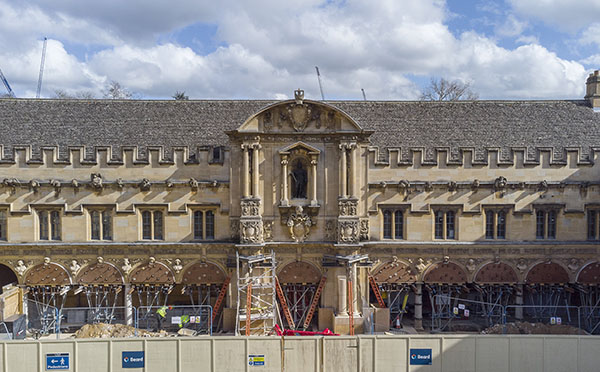 Overview of one façade with propping in placeExtensive repair, restoration and replacement work on the Grade One-listed Laudian Library extension in the Canterbury Quadrangle of St John’s College, Oxford is being carried out by Szerelmey, working alongside Beard Construction and Wright and Wright Architects. It follows the successful delivery of a package of works to create a new library and study centre, with artwork walls and interior and exterior paving which was completed by Szerelmey in 2019. The Canterbury Quadrangle is one of the most famous, historic and beautiful of Oxford’s buildings.
Overview of one façade with propping in placeExtensive repair, restoration and replacement work on the Grade One-listed Laudian Library extension in the Canterbury Quadrangle of St John’s College, Oxford is being carried out by Szerelmey, working alongside Beard Construction and Wright and Wright Architects. It follows the successful delivery of a package of works to create a new library and study centre, with artwork walls and interior and exterior paving which was completed by Szerelmey in 2019. The Canterbury Quadrangle is one of the most famous, historic and beautiful of Oxford’s buildings.
 Frontis temporary works propping with ongoing fluted column replacementsSt John’s College was founded in 1555 with its original library containing a collection of around 150 mostly theological, philosophical and legal books. Over the intervening years the college and its libraries have slowly evolved to present a fascinating collection of different English architectural styles – a mini potted history from the 16th century to the present day.
Frontis temporary works propping with ongoing fluted column replacementsSt John’s College was founded in 1555 with its original library containing a collection of around 150 mostly theological, philosophical and legal books. Over the intervening years the college and its libraries have slowly evolved to present a fascinating collection of different English architectural styles – a mini potted history from the 16th century to the present day.
The Laudian Library, which forms the eastern range of the Canterbury Quadrangle, was built between 1631-36 by William Laud, then Archbishop of Canterbury who was beheaded in 1645. It is fronted by a striking loggia, with an elaborate centrepiece, possibly by the sculptor Nicholas Stone (1586-1647).
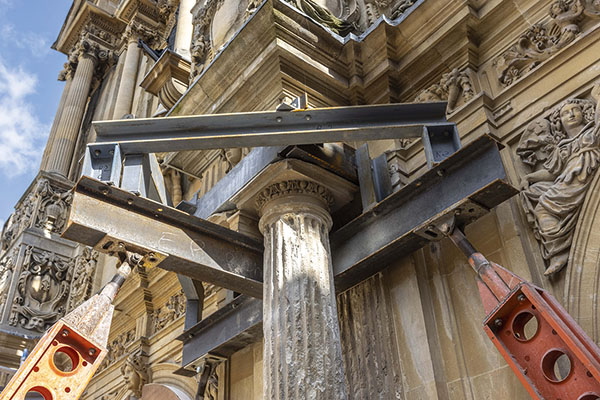 Frontis projection temporary works propping arrangementThe west side of the Quadrangle mirrors the east and has a similar loggia and centrepiece. On both elevations the frontispiece rises to three storeys, with decorative niches and figurines of Charles I. Both elevations/colonnades feature highly-decorative stonework with Historic England citing Richard Maude, Hugh Davis and Robert Smith as the masons and John Jackson, Anthony Gore and Harry Acres as the carvers. They are supported on a series of arches and free-standing columns. They are baroque in style and are a classic and rare example of the style still remaining in the UK, making them of particular historic importance.
Frontis projection temporary works propping arrangementThe west side of the Quadrangle mirrors the east and has a similar loggia and centrepiece. On both elevations the frontispiece rises to three storeys, with decorative niches and figurines of Charles I. Both elevations/colonnades feature highly-decorative stonework with Historic England citing Richard Maude, Hugh Davis and Robert Smith as the masons and John Jackson, Anthony Gore and Harry Acres as the carvers. They are supported on a series of arches and free-standing columns. They are baroque in style and are a classic and rare example of the style still remaining in the UK, making them of particular historic importance.
Each of the colonnades consists of eight freestanding columns approximately 2.7m apart and six half columns. The colonnades are constructed from load-bearing Headington stone, with the original columns in Bletchingdon marble. They measure 2,100mm tall x 349mm diameter in the centre, reducing to 308mm diameter at the top taking account of the entasis. The cloisters behind are laid out with a mixture of Purbeck and sandstone. Over the years the structure has been subject to many restorations and underpinning works, including five full column replacements in 1905, when Portland stone was used.
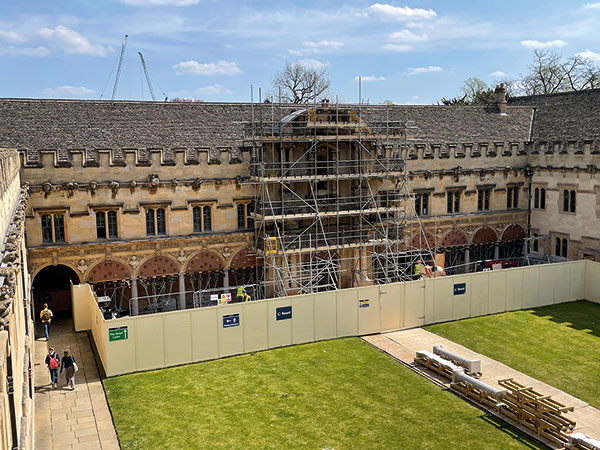 East cloister view with access scaffolding in place to facilitate high level frontis survey and repair worksRecently it was identified that the columns were beginning to fail structurally and that a cosmetic repair would be insufficient. Following extensive surveys and ground condition test excavations, immediate works involved installing steel collars to five seriously cracked or split colonnade columns and the installation of substantial temporary steel props to support the arches. Szerelmey were engaged to design the temporary works to allow the removal and replacement of the colonnade columns and half columns, and further temporary works to support the frontispieces to allow the removal and replacement of the ground-to-first-floor fluted columns.
East cloister view with access scaffolding in place to facilitate high level frontis survey and repair worksRecently it was identified that the columns were beginning to fail structurally and that a cosmetic repair would be insufficient. Following extensive surveys and ground condition test excavations, immediate works involved installing steel collars to five seriously cracked or split colonnade columns and the installation of substantial temporary steel props to support the arches. Szerelmey were engaged to design the temporary works to allow the removal and replacement of the colonnade columns and half columns, and further temporary works to support the frontispieces to allow the removal and replacement of the ground-to-first-floor fluted columns.
The local Bletchingdon marble, which the original columns had been crafted from, was no longer available, the quarry having closed many years previously. That meant a lengthy process of material sampling had to be undertaken to find a suitable alternative, which also had to be approved by the Oxford City Planning Department and Historic England. Eventually the carboniferous limestone, Swaledale fossil, was identified as the preferred replacement. The chosen stone was subjected to an extensive laboratory testing schedule and the results were used to prove the suitability of the stone by Szerelmey’s in house design department, in line with relevant design codes.
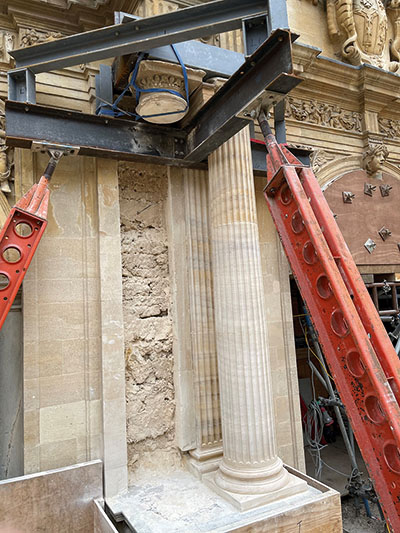 Historic eroded fluted pilaster panel removed to enable new fluted pilaster installationA similar sampling process was carried out to select the correct material for the cloister paving – with Purbeck Wetson Bed and Crosland Hill chosen – and for the general repairs and repairs to the frontispieces, for which Clipsham Medwell was selected. As can often happen when working with historic and fragile structures, when the existing frontis fluted columns were removed, it was found that the pilasters directly behind them had also deteriorated beyond restoration and had to be replaced. On-site templates and moulds were taken and the pilasters were replaced using Clipsham stone from the Medwell quarry.
Historic eroded fluted pilaster panel removed to enable new fluted pilaster installationA similar sampling process was carried out to select the correct material for the cloister paving – with Purbeck Wetson Bed and Crosland Hill chosen – and for the general repairs and repairs to the frontispieces, for which Clipsham Medwell was selected. As can often happen when working with historic and fragile structures, when the existing frontis fluted columns were removed, it was found that the pilasters directly behind them had also deteriorated beyond restoration and had to be replaced. On-site templates and moulds were taken and the pilasters were replaced using Clipsham stone from the Medwell quarry.
All the columns – full round, half round and fluted frontis – and the pilasters were surveyed dimensionally and templates taken where required. The information was drafted up in house and issued for approval to the design team to include the introduction of lead DPCs at the junction of the column shafts and column bases to protect against groundwater penetration, and therefore improving the longevity of the replacement stones while maintaining the historical precedence. Once approved the drawings were issued to the different quarries for manufacturing the new pieces.
The fluted frontis columns and pilasters were manufactured by Stamford Stone and delivered to site as loose pieces at one third heights each. Once the temporary works were installed and signed off, replacement could take place by fully dismantling a column and its adjacent pilaster and then re-building them with new stone before moving on to the next column and pilaster.
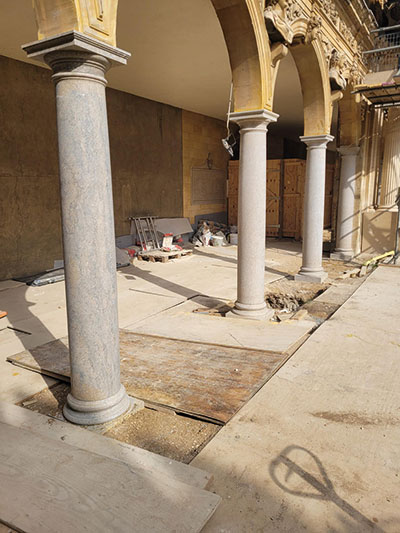 New full and half columns installed with temporary propping removed to enable paving works to commenceThe chosen stone for the colonnade columns and half columns, Swaledale Fossil, is sourced from a quarry which has restrictions on the size of the blocks. Because of that the decision was made to split the column into three pieces, mirroring the existing condition, in order to achieve the column heights. That was done by using the base (naturally bed), shaft (turned vertically off bed) and capital (naturally bed) to achieve the required height. The full and round columns were manufactured and pre-assembled by Dunhouse Quarry Ltd and delivered to site as single units in specially designed timber pallets. Pre-assembly consisted of internally pinning the base, entasis shaft and capital together to form a complete column. Once the temporary works were installed and signed off, replacement could take place in a ‘hit-and-miss’ manner – ie remove and replace columns 1, 3, 5 and 7 before removing and replacing columns 2, 4, 6 and 8.
New full and half columns installed with temporary propping removed to enable paving works to commenceThe chosen stone for the colonnade columns and half columns, Swaledale Fossil, is sourced from a quarry which has restrictions on the size of the blocks. Because of that the decision was made to split the column into three pieces, mirroring the existing condition, in order to achieve the column heights. That was done by using the base (naturally bed), shaft (turned vertically off bed) and capital (naturally bed) to achieve the required height. The full and round columns were manufactured and pre-assembled by Dunhouse Quarry Ltd and delivered to site as single units in specially designed timber pallets. Pre-assembly consisted of internally pinning the base, entasis shaft and capital together to form a complete column. Once the temporary works were installed and signed off, replacement could take place in a ‘hit-and-miss’ manner – ie remove and replace columns 1, 3, 5 and 7 before removing and replacing columns 2, 4, 6 and 8.
The columns were installed using a bespoke lifting cradle, designed by RDG Engineering, to tilt and position them in place. Joints between the new concrete bases and between the capital and existing springer stones were then grouted and cured, ensuring a full bed for load transferring before the temporary works can be released and subsequently removed.
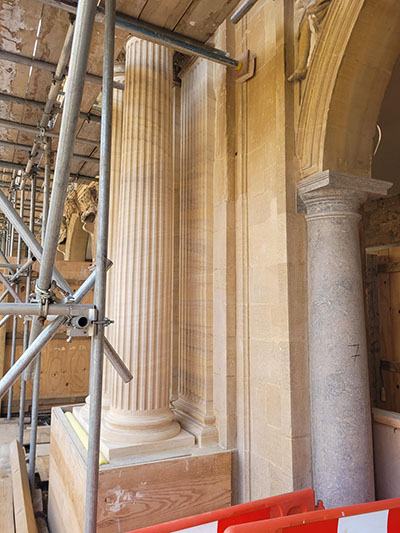 Newly installed fluted pilaster panel, half and fluted columnsThroughout the duration of the column replacement works periodic movement monitoring has been undertaken to ensure both the temporary works and subsequently the replacement columns are correctly supporting the structure with no excessive movement. During the removal of the temporary works and transfer of loads to the newly installed columns, monitoring is continuously undertaken in conjunction with phased temporary works removal, to ensure a sympathetic and controlled transfer of loads from the temporary works to the new structure. During the consultation period and works, consideration has always been given to minimising the interventions required, in order to maintain the historical precedence of the building wherever possible.
Newly installed fluted pilaster panel, half and fluted columnsThroughout the duration of the column replacement works periodic movement monitoring has been undertaken to ensure both the temporary works and subsequently the replacement columns are correctly supporting the structure with no excessive movement. During the removal of the temporary works and transfer of loads to the newly installed columns, monitoring is continuously undertaken in conjunction with phased temporary works removal, to ensure a sympathetic and controlled transfer of loads from the temporary works to the new structure. During the consultation period and works, consideration has always been given to minimising the interventions required, in order to maintain the historical precedence of the building wherever possible.
Internally, new Purbeck Wetson Bed flooring is to be installed in a number of WC and storage areas. They have been duly surveyed and scheduled and will be installed by Szerelmey masons. Externally, a number of entrance steps are to be replaced utilising Crosland Hill stone. Again, in each instance Szerelmey have surveyed and scheduled and will install them, ensuring continued access to the buildings during the phased installation.
Operations director Tamsin Pickeral commented: “Szerelmey Restoration and Stonework has been in business for a long while and has carried out restoration and conservation works on a great many listed buildings. It is an absolute privilege to work on the buildings we do and to work with clients and architects who are as passionate about restoration as we are!”
• For further information visit www.szerelmey.com













